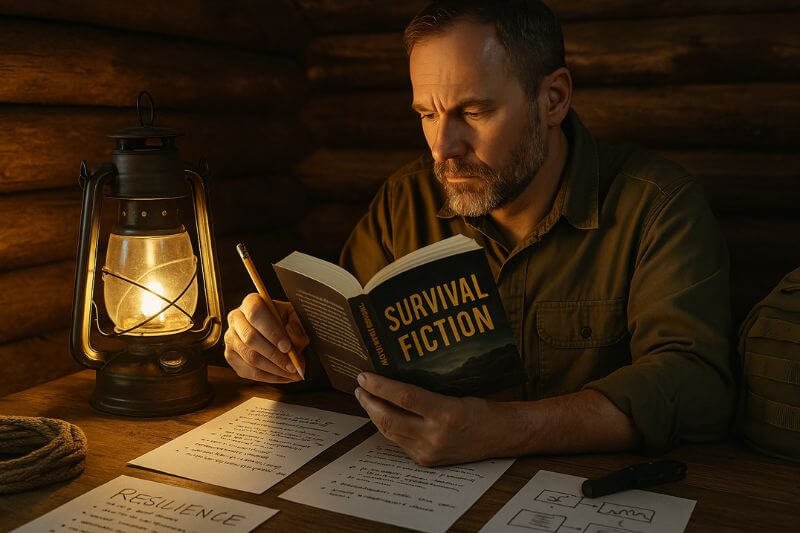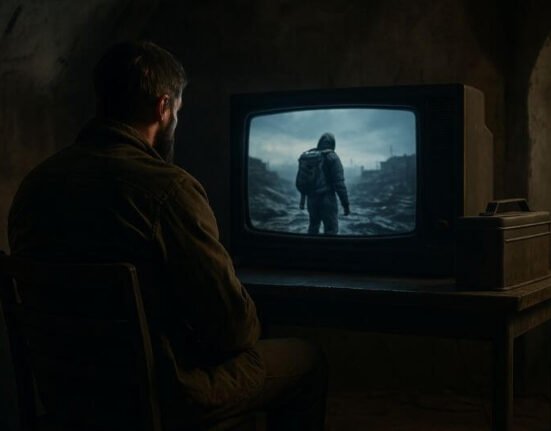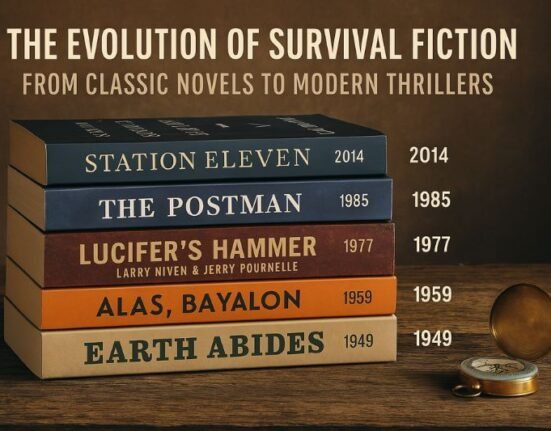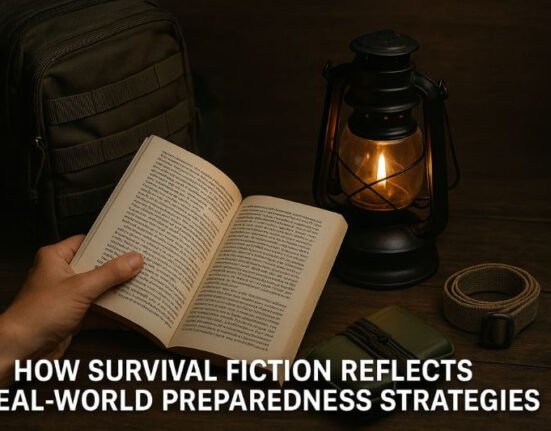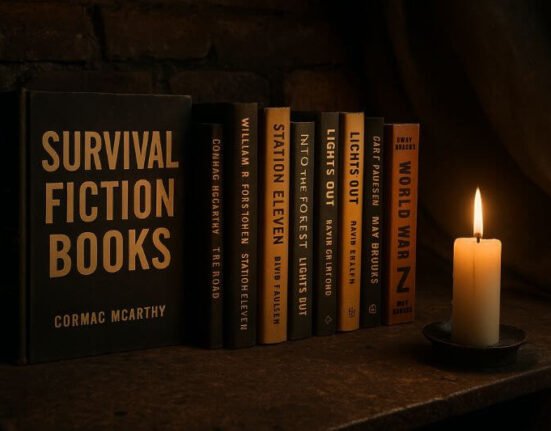By analyzing survival fiction, we uncover something deeper than storylines or action — we reveal the fragile balance between collapse and endurance, fear and hope, instinct and ethics.
These stories, whether told through books or films, aren’t just about staying alive. They show us how people adapt, what breaks them, and most importantly, what helps them bounce back.
In an age of global uncertainty, pandemics, and social unrest, understanding the psychological lessons embedded in fiction gives preppers and resilience-minded individuals an unexpected but powerful edge.
Survival fiction doesn’t just describe disaster — it explores how people overcome it.
💡 Why Fiction Is the Ideal Lens to Study Resilience
Fictional survival stories offer something manuals and documentaries often don’t: emotional immersion.
Here’s what makes fiction so effective for teaching real resilience:
| Fictional Element | Real-World Benefit |
|---|---|
| Emotional arcs | Builds empathy and psychological preparation |
| Character flaws | Reflect our own limits and blind spots |
| Social tension | Models group survival, conflict, and breakdown |
| Moral choices | Reveals decision-making pressure under duress |
| Uncertainty | Simulates stress from unknown variables |
Stories aren’t hypothetical — they’re emotional rehearsal.
And in survival fiction, every plot twist becomes a mental stress test.
🔍 Key Themes of Resilience in Survival Fiction
Across novels, films, and even games, we find recurring psychological themes tied directly to real-world survival behavior.
Here are the most important patterns to observe when analyzing survival fiction:
🧍♂️ Isolation and Mental Decline
From The Road to Into the Wild, isolation leads to hallucination, depression, and weakened decision-making.
Lesson: Social bonds and purpose are core components of survival.
🧠 Adaptation Under Pressure
Characters who pivot — even against their instincts — survive. Think of the protagonists in Greenland or One Second After.
Lesson: Flexibility is more important than strength.
🫂 Collective vs Individual Survival
In The Postman, community wins. In The Divide, isolation breeds savagery.
Lesson: Cooperation is a force multiplier — but only with trust and boundaries.
🔎 Case Studies – Characters That Embody Resilience
To truly benefit from analyzing survival fiction, we need to study how fictional characters respond to trauma, threat, and loss. Their reactions — from denial to adaptation — mirror real psychological patterns observed in disaster survivors.
Let’s break down a few of the most compelling examples:
🧔 The Father in The Road (2009)
- Context: A father and son journey through a burned, lifeless America.
- Resilience Mechanism: Purpose. His singular mission — to keep his son alive — gives him strength.
- Emotional Core: He suppresses fear, starvation, and despair through emotional discipline.
- What We Learn:
- Purpose sustains people through despair.
- Love can override fear and trauma.
- Emotional control is often a survival mechanism.
👩 Nell in Into the Forest (2015)
- Context: Two sisters survive alone in the woods after societal collapse.
- Resilience Mechanism: Adaptation and trust.
- Emotional Core: Transition from passive victimhood to empowered autonomy.
- What We Learn:
- Women in survival fiction often mirror real-world emotional adaptability.
- Practical skills (gardening, self-defense, medicine) rebuild control over life.
👨🏫 Professor in Station Eleven (2014)
- Context: A pandemic wipes out most of the world. Survivors form tribes, a traveling theatre troupe, and cults.
- Resilience Mechanism: Cultural preservation.
- Emotional Core: Recovery through meaning, not power.
- What We Learn:
- Art, memory, and storytelling are forms of psychological resilience.
- Keeping culture alive is as vital as food and shelter.
🧩 Fiction vs Reality – When Stories Match Science
Survival fiction often aligns with psychological models of human response to crisis.
| Resilience Factor | Fictional Example | Real-Life Parallels |
|---|---|---|
| Meaning & Purpose | The Road | Viktor Frankl’s “Man’s Search for Meaning” |
| Adaptive Behavior | How It Ends | PTSD recovery studies: agency helps healing |
| Community Support | The Postman | Crisis studies: group morale boosts long-term survival |
| Moral Clarity | Contagion, Greenland | Ethics during triage decisions or food scarcity |
| Resourcefulness | Hatchet, Cast Away | Real wilderness survival case reports |
📘 These examples show how fiction acts as a cognitive rehearsal for resilience.
Every tough choice, loss, or moment of growth in a story is a training point for readers and viewers.
🧠 Conclusion – Fiction Trains the Heart of a Survivor
When we’re analyzing survival fiction, we’re not just studying how people survive disasters. We’re examining how they stay human.
These stories strip away modern comfort and reveal the psychological core of endurance:
- Purpose
- Adaptability
- Connection
- Courage
- Reflection
Fictional collapse teaches us what manuals cannot: how it feels to face the end… and choose to rebuild.
If you want to grow your resilience — start not just with training and gear — but with stories that force you to think, feel, and decide under pressure.
Turn Every Story Into Survival Training
🎥 Next time you read a novel or watch a survival fiction film, use it as a simulation.
🧠 Ask:
- What did the character do wrong?
- What skills helped them survive?
- How did they recover — emotionally, morally, or socially?
Then turn insights into action:
➡️ Resilience Training Exercises
➡️ Survival Fiction Book List
➡️ Mental Prepper Workbook – Free PDF
Because the greatest prepping tool is a mind that’s already been through the storm — even if only on the page.
❓ Frequently Asked Questions (FAQ)
Q: How is analyzing survival fiction different from just enjoying it?
Analysis means active learning. You look at behavior, psychology, patterns, and outcomes — not just entertainment. It transforms fiction into training for crisis logic.
Q: Can fiction really prepare me for real disasters?
Yes — indirectly. Studies show that emotional rehearsal improves reaction time, decision-making, and recovery in real-world trauma. Fiction is a low-risk way to engage that process.
Q: What should I focus on when analyzing a survival story?
- How the characters change over time
- Their critical decisions and what triggered them
- How they balance morality vs. survival
- What skills, mindsets, or social tools made a difference
Q: Should I analyze fiction alone or in groups?
Both. Solo reflection deepens your personal resilience. But discussing stories with a prepper group, class, or partner can lead to strategic insight and stronger community understanding.
Q: Are there survival fiction stories that focus on psychological recovery?
Yes. Station Eleven, Into the Forest, and The Dog Stars focus deeply on grief, healing, and internal strength. These are as vital to resilience as any knife or bug-out bag.









